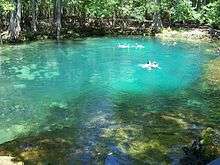Manatee Springs State Park
Manatee Springs State Park is a Florida State Park located six miles west of Chiefland on SR 320, off US 19. Manatee Spring is a first magnitude spring that flows directly into the Suwannee River by way of a short run (though it is the longest spring run feeding the Suwannee River). Present also are swamps and hardwood wetlands along the Suwannee, along with many sinkhole ponds, including one with a cave 90 feet below the ground that connects to a popular divers' destination known as the catfish hotel.
| Manatee Springs State Park | |
|---|---|
IUCN category V (protected landscape/seascape) | |
 Map of the United States | |
| Location | Levy County, Florida, USA |
| Nearest city | Chiefland |
| Coordinates | 29°29′25.49″N 82°58′37.47″W |
| Governing body | Florida Department of Environmental Protection |
| Designated | December 1971 |

History
Manatee Springs was visited in 1774 by William Bartram (1739–1823) and described in his book Travels through North & South Carolina, East & West Florida, the Cherokee Country, the Extensive Territories of the Muscogulges, or Creek Confederacy, and the Country of the Chactaws, Containing an Account of the Soil and Natural Productions of Those Regions, Together with Observations on the Manners of the Indians (1791); it was named by Bartram himself ("Manate Springs") after seeing a manatee carcass on the shoreline of the spring run.
Biology
Tree types in the park consist of cypress, sweetgum, maple and ash.
Largemouth bass, speckled perch, catfish and bream and longnose gar are some of the fish in this part of the Suwannee. White-tailed deer and various small mammals and birds can also be seen in the park year-round.
Manatees, for which the spring is named, are more commonly seen in fall and winter, as the constant 72 °F (23 °C) temperature acts as a warm haven for them. Manatees cannot survive long in cold water, so the spring provides a good place to calve and shelter if winter is particularly harsh.
The spring also attracts large numbers of American black vultures, who winter here. The surprising number of birds makes for a somewhat Gothic spectacle, with moss-draped cypress trees surrounding the spring run filled with large, black birds. The vultures aren't particularly afraid of humans, but are not aggressive either.
Recreational activities

Activities include hiking, biking, kayaking, canoeing, as well as scuba diving, swimming, snorkeling and wildlife viewing. Some of the amenities are a floating dock, boardwalk, eight miles of wooded off-road trails, picnic Pavilions and full camping facilities.
Swimming in the head spring and run is forbidden in winter, when manatees are more likely to be sheltering there. The so-called "catfish hotel" sinkhole and karst window near the main spring remains open year-round with access to these caverns. Swimming and snorkeling is not allowed in the catfish hotel, and is generally unpleasant due to the layer of duck weed covering the water. Sue sink is listed as an emergency exit only for cave divers in the system as ingress and egress is hazardous to the diver and causes soil erosion. Friedman sink is available as an entrance to certified cave divers, and is the furthest upstream entrance to the system.
Certified Open Water divers can dive the head spring with lights, as well as the catfish hotel cavern without lights. Certified Cavern divers can dive the catfish hotel cavern with lights, but are not to explore beyond the daylight zone. Cavern divers should also exhibit caution when nearing the siphon side of the catfish hotel cavern, as the flow is immense. Certified and qualified cave divers are able to explore several miles of caverns which feed into the spring.
Hours
The park is open from 8:00 am till sundown year round.
References and external links
| Wikimedia Commons has media related to Manatee Springs State Park. |
- Manatee Springs State Park at Florida State Parks
- Manatee Springs State Park at State Parks
- Manatee Springs State Park at Absolutely Florida
- Manatee Springs State Park at Wildernet